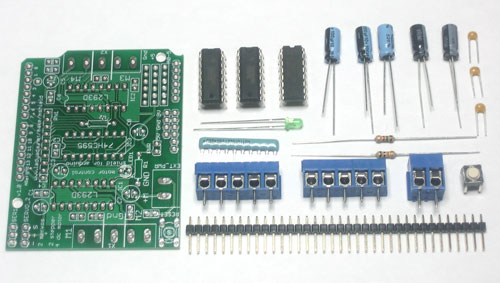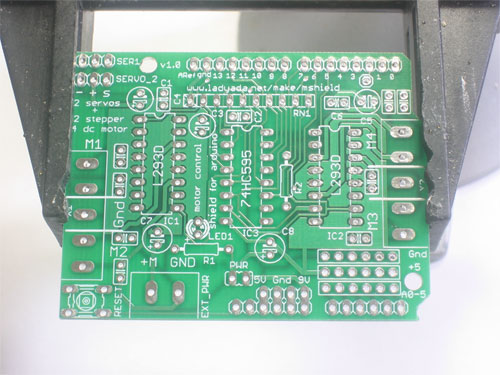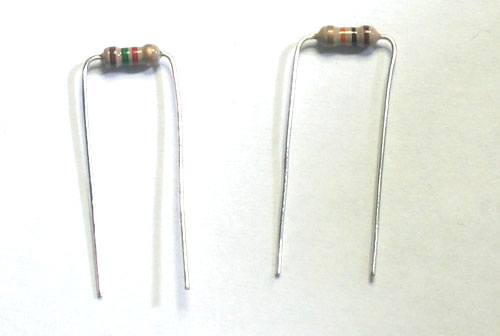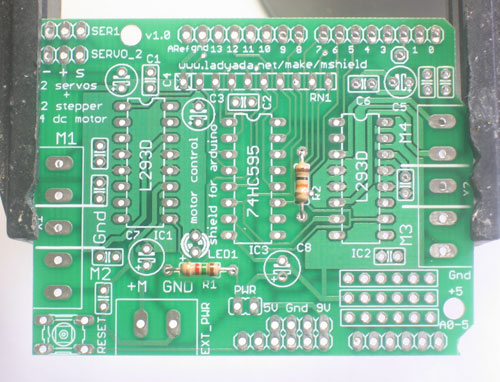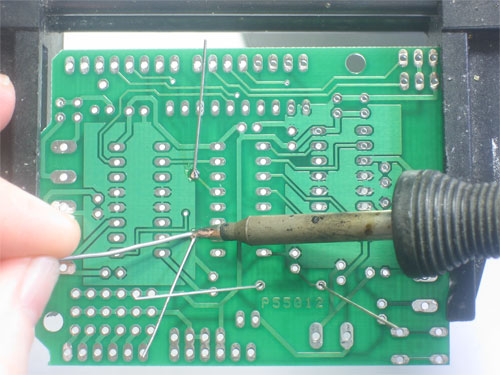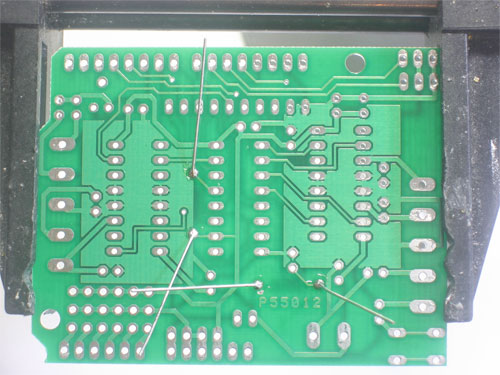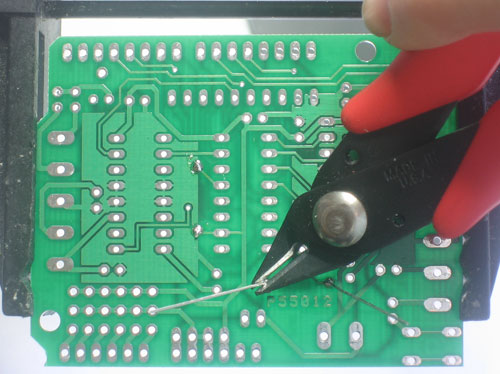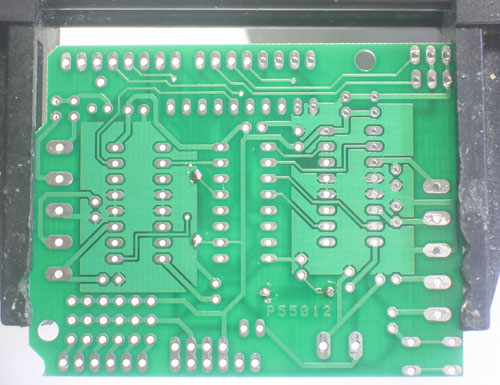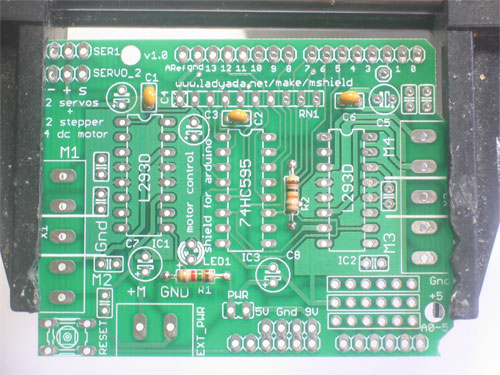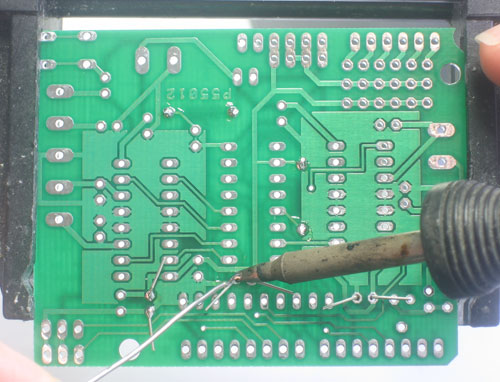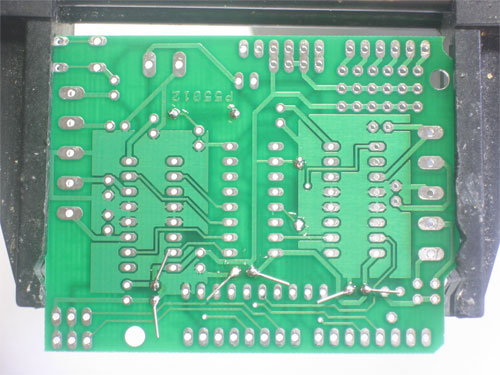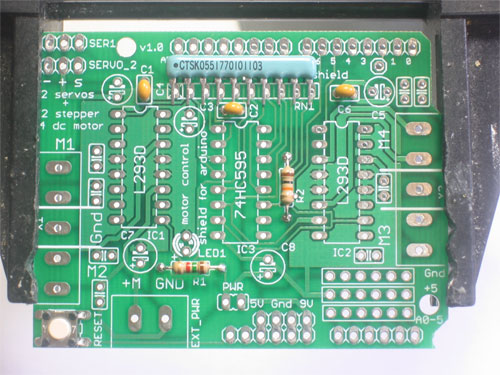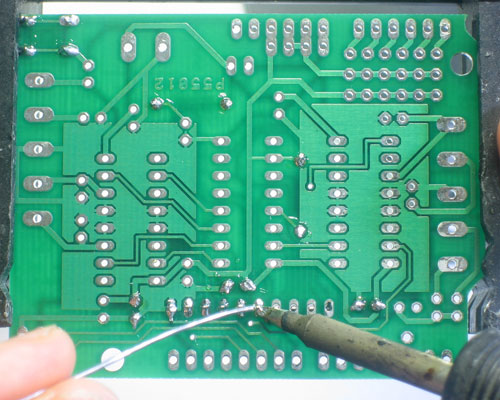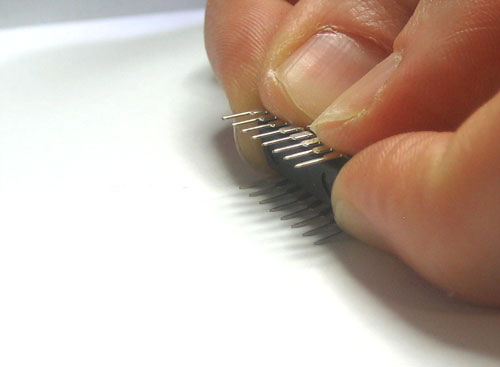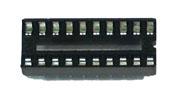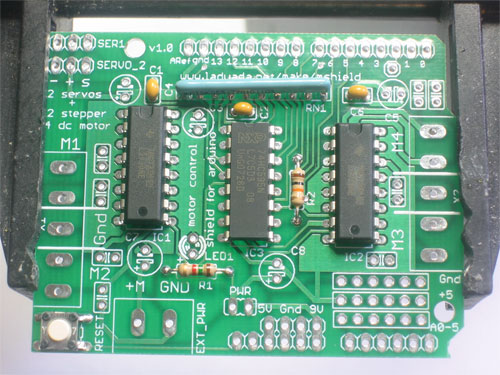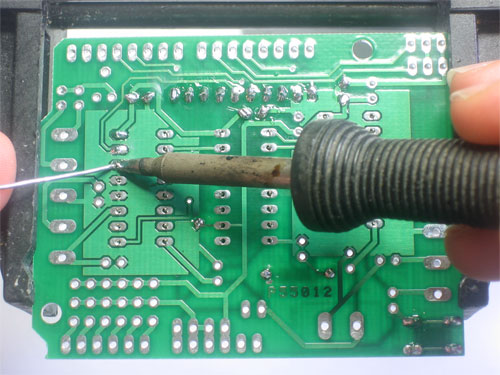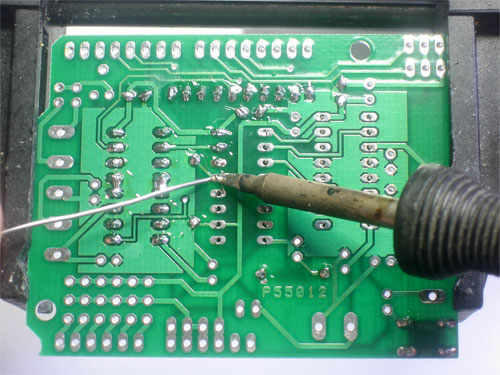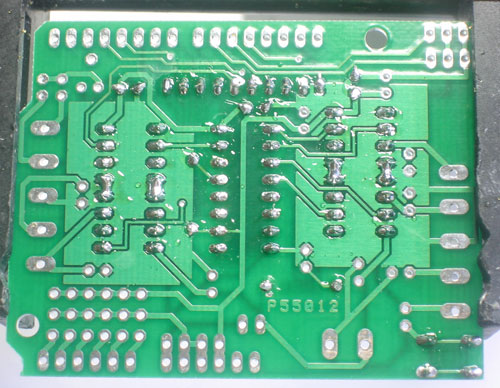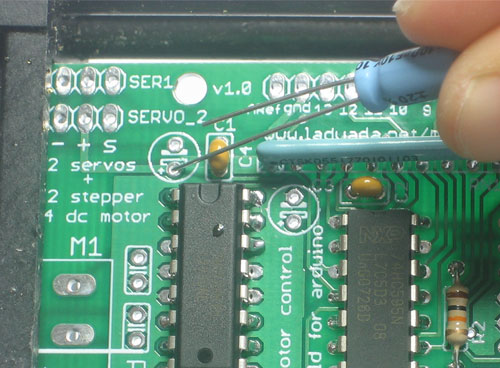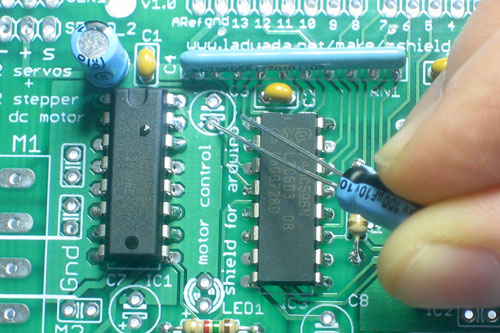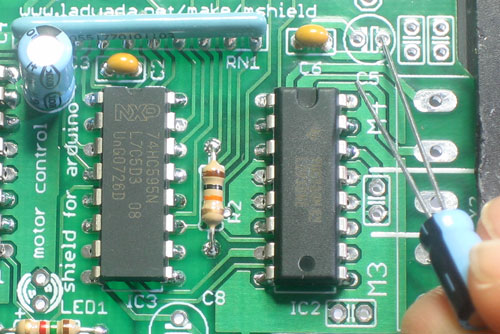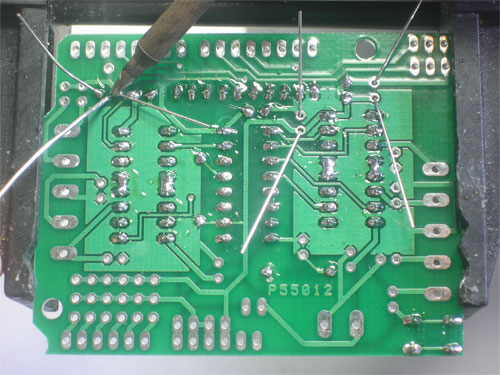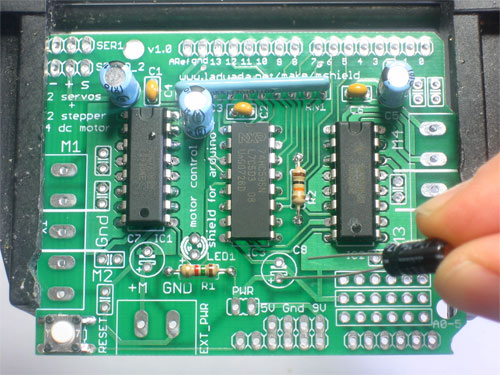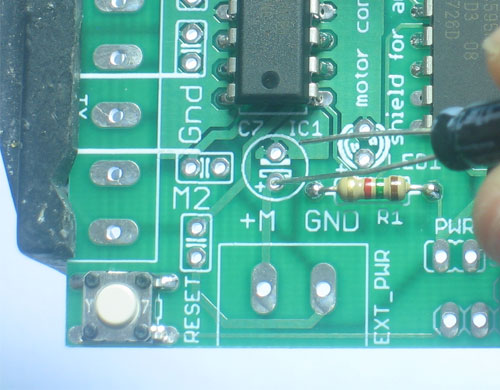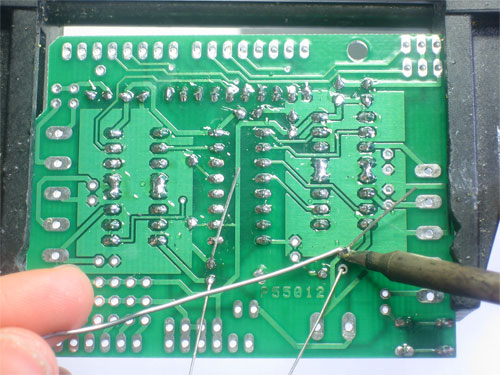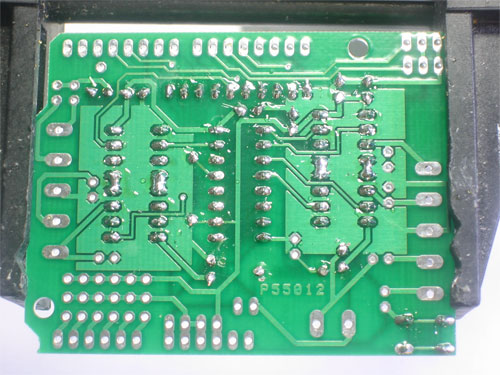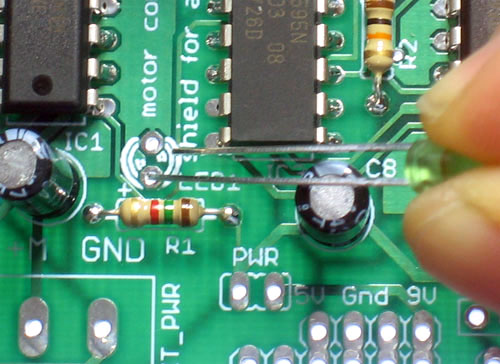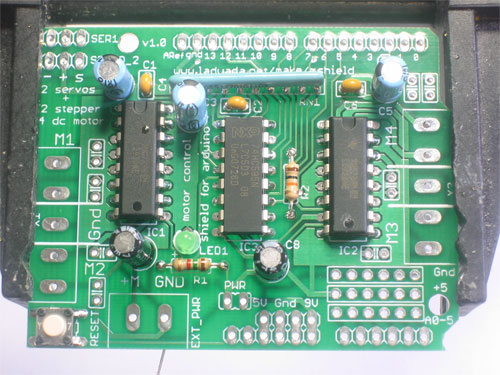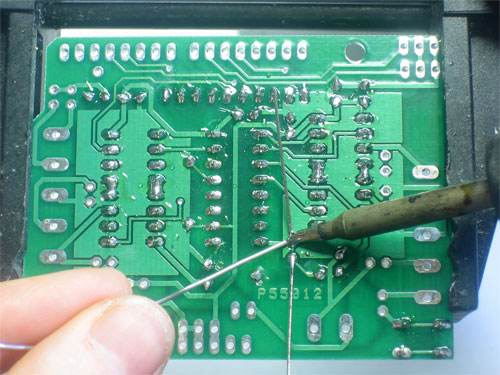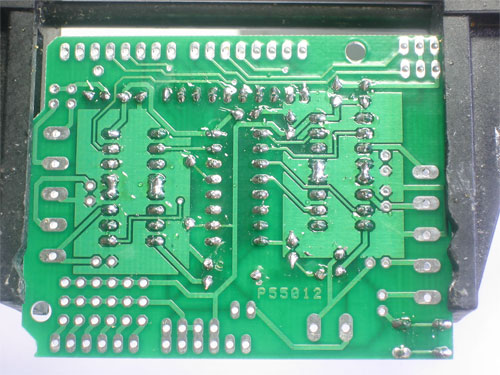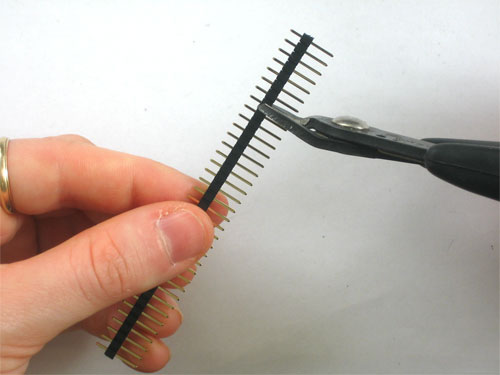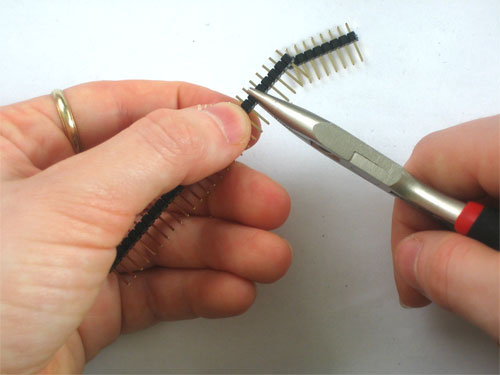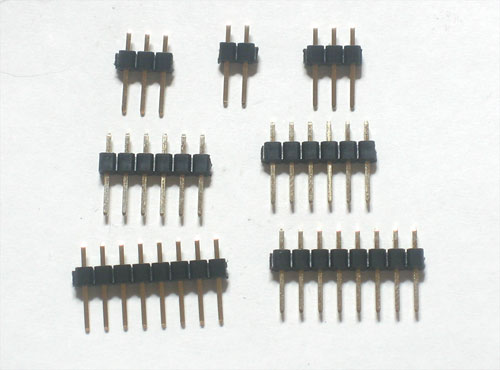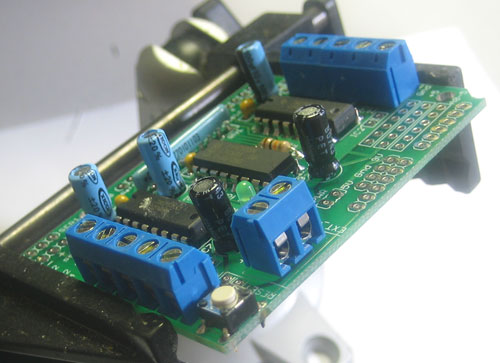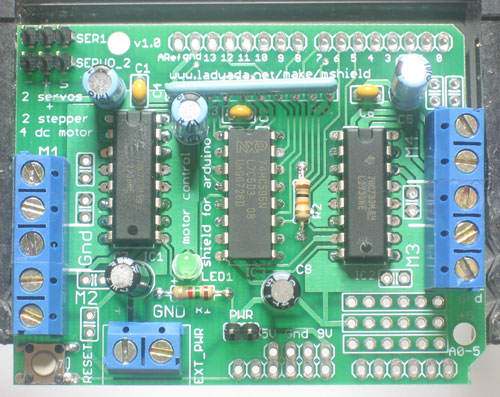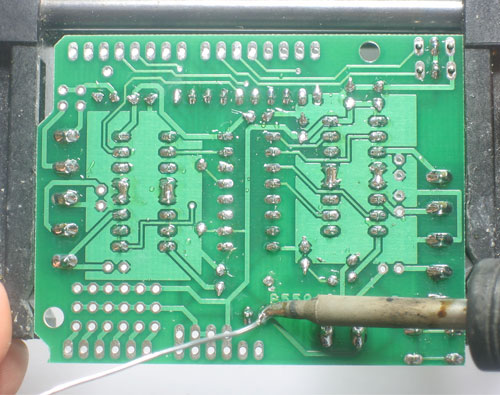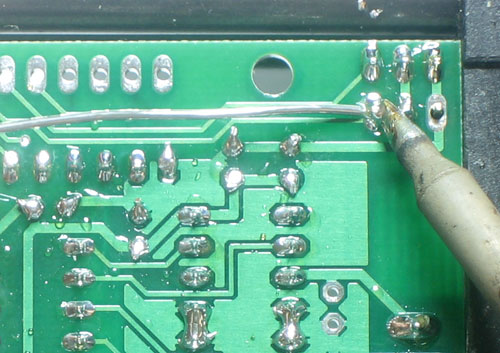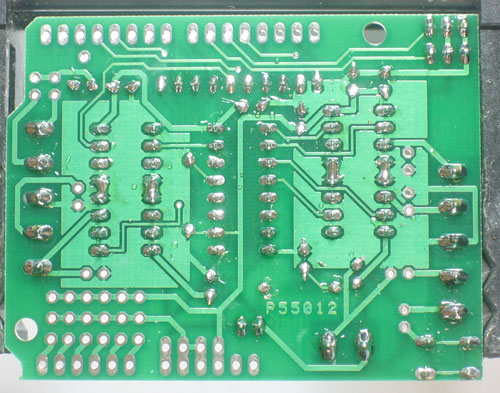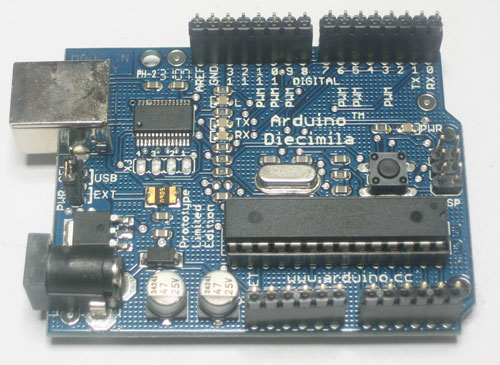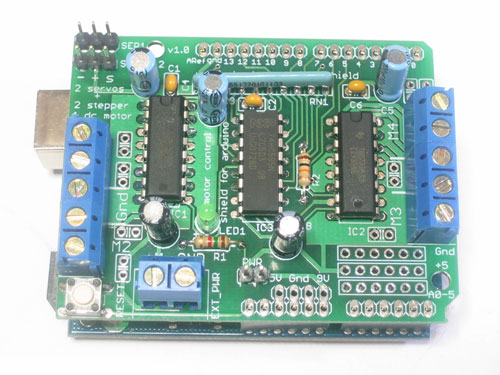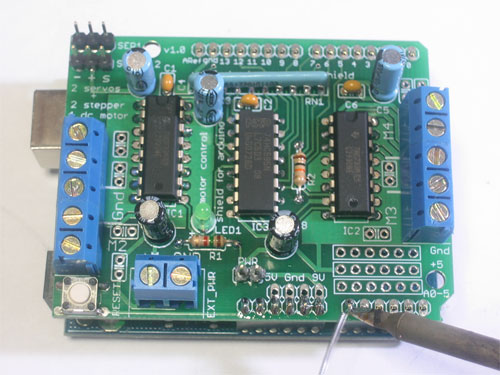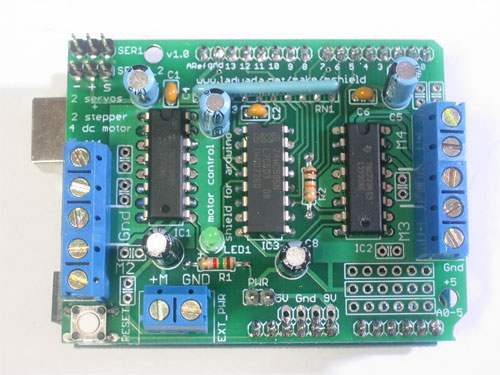Différences entre versions de « AdaFruit Motor Shield Souder »
| Ligne 3 : | Ligne 3 : | ||
[[Fichier:MOTOR-SHIELD-SOUDER-01.jpg]] | [[Fichier:MOTOR-SHIELD-SOUDER-01.jpg]] | ||
| − | + | Premièrement, vérifier tous le composants. Vous pouvez utiliser la [[AdaFruit Motor Shield Liste|Liste des pièces]] pour vous aider. | |
[[Fichier:MOTOR-SHIELD-SOUDER-02.jpg]] | [[Fichier:MOTOR-SHIELD-SOUDER-02.jpg]] | ||
| − | + | Placez le PCB (carte) du shield moteur sur un [http://mchobby.be/PrestaShop/product.php?id_product=154 étau Panavise] ou un support pour breadboard. Faites ensuite chauffer votre fer à souder (à 700 degrées si la température est réglable). | |
[[Fichier:MOTOR-SHIELD-SOUDER-03.jpg]] | [[Fichier:MOTOR-SHIELD-SOUDER-03.jpg]] | ||
| − | + | Les premiers composants que nous allons souder sont les deux résistances '''R1''' (Brun Vert Rouge Or) et '''R2''' (Brun Noir Orange Or). | |
| + | |||
| + | Courbez les broches des résistance de façon à les faire tenir bien en place (comme sur la photographie) | ||
[[Fichier:MOTOR-SHIELD-SOUDER-04.jpg]] | [[Fichier:MOTOR-SHIELD-SOUDER-04.jpg]] | ||
| − | + | Placez ensuite les résistances bien à plat sur la carte (comme montré). Tordez un peu les fils/broches des résistances en dessous du PCB. De cette façon, les résistances resterons bien en place lorsque vous retournerez la carte pour faire vos soudures. | |
| − | + | Les résistances ne sont pas polarisées, vous pouvez les monter dans n'importe quel sens... elle fonctionnerons parfaitement. | |
[[Fichier:MOTOR-SHIELD-SOUDER-05.jpg]] | [[Fichier:MOTOR-SHIELD-SOUDER-05.jpg]] | ||
| − | + | Chauffez en même temps la broche et la pastille à l'aide de la pointe de votre fer à souder (pendant une à 2 secondes). Ajoutez ensuite un peu de soudure, elle fondra et formera un charmant petit cone. Retirez la soudure puis le fer à souder. | |
| + | |||
| + | Répéter l'opération pour les 4 fils. | ||
[[Fichier:MOTOR-SHIELD-SOUDER-06.jpg]] | [[Fichier:MOTOR-SHIELD-SOUDER-06.jpg]] | ||
| − | + | Vérifiez votre travail, vous devez obtenir un joint de soudure bien propre. | |
[[Fichier:MOTOR-SHIELD-SOUDER-07.jpg]] | [[Fichier:MOTOR-SHIELD-SOUDER-07.jpg]] | ||
| − | + | Utilisez votre pince coupante les broches juste à ras de la soudure (du cône). | |
[[Fichier:MOTOR-SHIELD-SOUDER-08.jpg]] | [[Fichier:MOTOR-SHIELD-SOUDER-08.jpg]] | ||
| Ligne 35 : | Ligne 39 : | ||
[[Fichier:MOTOR-SHIELD-SOUDER-09.jpg]] | [[Fichier:MOTOR-SHIELD-SOUDER-09.jpg]] | ||
| − | + | Plaçons maintenant les 3 capacités céramiques jaune '''C4''', '''C2''' et '''C6'''. Les capacités céramique ne sont pas polarisées, vous pouvez donc les raccorder dans les deux sens sans danger (elle fonctionnerons bien). | |
| − | + | Courbez les broches comme vous l'avez fait pour les résistances. | |
[[Fichier:MOTOR-SHIELD-SOUDER-10.jpg]] | [[Fichier:MOTOR-SHIELD-SOUDER-10.jpg]] | ||
| − | + | Soudez les 6 broches. Coupez ensuite les excédents à l'aide d'une pince coupante (comme pour les résistances). | |
[[Fichier:MOTOR-SHIELD-SOUDER-11.jpg]] | [[Fichier:MOTOR-SHIELD-SOUDER-11.jpg]] | ||
Version du 7 décembre 2012 à 11:41
Premièrement, vérifier tous le composants. Vous pouvez utiliser la Liste des pièces pour vous aider.
Placez le PCB (carte) du shield moteur sur un étau Panavise ou un support pour breadboard. Faites ensuite chauffer votre fer à souder (à 700 degrées si la température est réglable).
Les premiers composants que nous allons souder sont les deux résistances R1 (Brun Vert Rouge Or) et R2 (Brun Noir Orange Or).
Courbez les broches des résistance de façon à les faire tenir bien en place (comme sur la photographie)
Placez ensuite les résistances bien à plat sur la carte (comme montré). Tordez un peu les fils/broches des résistances en dessous du PCB. De cette façon, les résistances resterons bien en place lorsque vous retournerez la carte pour faire vos soudures.
Les résistances ne sont pas polarisées, vous pouvez les monter dans n'importe quel sens... elle fonctionnerons parfaitement.
Chauffez en même temps la broche et la pastille à l'aide de la pointe de votre fer à souder (pendant une à 2 secondes). Ajoutez ensuite un peu de soudure, elle fondra et formera un charmant petit cone. Retirez la soudure puis le fer à souder.
Répéter l'opération pour les 4 fils.
Vérifiez votre travail, vous devez obtenir un joint de soudure bien propre.
Utilisez votre pince coupante les broches juste à ras de la soudure (du cône).
Plaçons maintenant les 3 capacités céramiques jaune C4, C2 et C6. Les capacités céramique ne sont pas polarisées, vous pouvez donc les raccorder dans les deux sens sans danger (elle fonctionnerons bien).
Courbez les broches comme vous l'avez fait pour les résistances.
Soudez les 6 broches. Coupez ensuite les excédents à l'aide d'une pince coupante (comme pour les résistances).
Next is the 6mm tactile switch RESET and the resistor network RN1. The tact switch is used to reset the Arduino since its not possible to reach the reset button once the motor shield is on.
The resistor network is used to pull-down the pins on the motor driver chips so that they don't power up the motors before the Arduino sketch tells them to.
The tactile switch can go in 'either way'. The resistor network, however, must go in a certain way. Make sure the end with a dot is posititioned so it is at the same end as the X in the silkscreened image of the resistor network. (See picture on left)
Flip the board over and solder in the resistor network and switch. You won't need to clip the leads as they are quite short aleady.
Next are the three integrated circuits (ICs) IC1, IC2 and IC3. When ICs come from the factory, the legs are angled out somewhat which makes it difficult to insert them into the PCB. Prepare them for soldering by gently bending the legs against a flat tabletop so that they are perfectly straight.
The latest kits from Adafruit come with 2 16-pin sockets for the L293D motor drivers. They are OPTIONAL and not necessary for operation.
If you are not experienced with driving motors ( your likelyhood of wiring up a mis-specified motor is high) you should install these so if the L293Ds are destroyed you can easily replace them
If you are experienced with driving motors, you may want to skip the sockets as the decrease the chips' heat-sinking abilities.
ICs must be placed in the correct orientation to work properly. To help with placement, each chip has a U notch at the top of the chip. On the circuit board there is a printed out image of the chip outline and one end has a U notch. Make sure the chip notch is on the same end as the image notch. In this PCB, all are facing the same way.
Gently insert the three chips. Check to make sure none of the legs got bent or broken.
The 74HC595 goes in the middle, and the two L293Ds go on either side.
Solder each pin of the chips.
The four 'middle' pins of the L293D motor driver chips are tied to a large heat sink and thus may end up getting 'bridged' with solder as shown in the second image.
Next are the three 100uF electrolytic capacitors C1, C3 and C5. Electrolytic capacitors are polarized and must be placed in the correct orientation or they could pop! The long leg of the capacitor is the positive (+) leg and goes into the hole marked with a +. The close-up images shown here indicate with hole is the + one.
Capacitors are not color-coded. The body color can vary from blue to violet to green to black so be sure to read the value on the side, don't depend on the color!
After double-checking their polarity, solder and clip the three capacitors
Place the two 47uF remaining electrolytic capacitors, C7 and C8
These are also polarized so make sure the long lead is inserted into the + hole in the silkscreened image.
Capacitors are not color-coded. The body color can vary from blue to violet to green to black so be sure to read the value on the side, don't depend on the color!
Solder and clip the two capacitors
Next is the 3mm LED used to indicate motor power. LEDs are polarized, just like capacitors, and the long lead is the positive (+) lead.
Make sure the LED is placed correctly otherwise it wont work!
Solder and clip the LED leads.
Next its time to make the headers for the jumper, servos and arduino.
We use one stick of 36-pin 'breakaway' header, and break it apart to make smaller strips. You can use diagonal cutters or pliers to snap off the pieces.
Break the 36-pin header into 2 8-pin, 2 6-pin, 2 3-pin and 1 2-pin headers.
If you have an NG arduino, you may want 1 6-pin header and 1 4-pin header instead of 2 6-pin headers.
The 2 3-pin pieces go in the servo connections in the top left corner. The 2-pin piece goes in the PWR jumper in the bottom center.
Also, place the 3 large screw terminals for the motor and external motor-power wires. If you received only 2 and 3-position terminal blocks, slide them together so that you have 2 5-position terminals and 1 2-position terminal.
Solder in the 3 pieces of header and the three terminal blocks
Next, place the 8-pin and 6-pin headers into the Arduino board. This will make sure that the headers are perfectly lined up. Make sure the Arduino is not plugged in or powered!
Place the motor shield on top of the Arduino, making sure that all the header lines up.
Solder in each pin of the header.
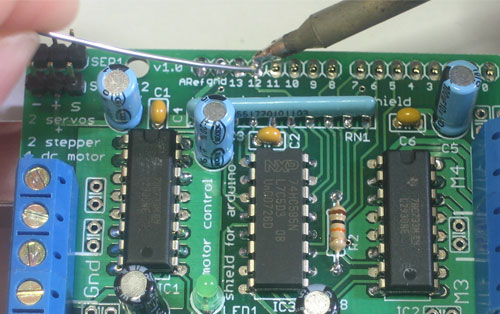
You're done!
Maintenant, vous pouvez lire manuel de l'utilisateur.
Traduit avec l'autorisation d'AdaFruit Industries - Translated with the permission from Adafruit Industries - www.adafruit.com
Toute référence, mention ou extrait de cette traduction doit être explicitement accompagné du texte suivant : « Traduction par MCHobby (www.MCHobby.be) - Vente de kit et composants » avec un lien vers la source (donc cette page) et ce quelque soit le média utilisé.
L'utilisation commercial de la traduction (texte) et/ou réalisation, même partielle, pourrait être soumis à redevance. Dans tous les cas de figures, vous devez également obtenir l'accord du(des) détenteur initial des droits. Celui de MC Hobby s'arrêtant au travail de traduction proprement dit.
